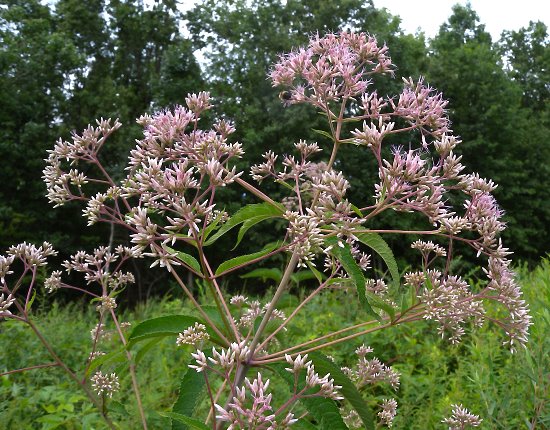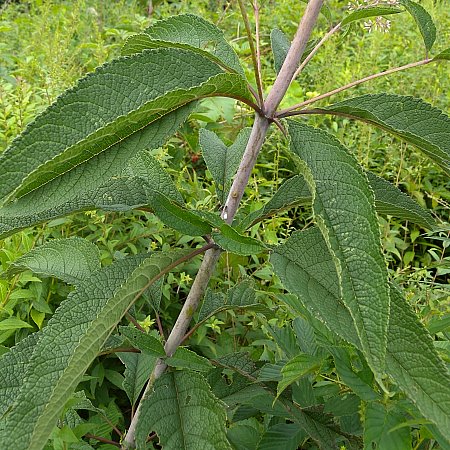
The central stem terminates in a panicle of flowerheads up to 1½' long and 1' across; the upper lateral stems often terminate in panicles of flowerheads as well, except they are smaller in size. Individual panicles are rather open and dome-shaped at the top; they vary in color from pale pink-lavender to deep rosy pink. Individual flowerheads are about 9 mm. (1/3") long and 3 mm. (1/8") across, consisting of 5-7 disk florets and no ray florets. Each disk floret consists of a narrowly cylindrical corolla with 5 upright lobes, 5 inserted stamens, and a pistil with an exserted bifurcated style. The corolla is pink-lavender to rosy pink. At the base of each flowerhead, there are overlapping bracts (phyllaries) that are appressed together in several series. These bracts are usually linear-oblong, white with pink tints to light pink, and glabrous. The branches of each panicle are widely spreading to ascending; they are usually dark purple and finely pubescent. The blooming period occurs from mid-summer to early fall and lasts about 1 month. The flowerheads are often mildly fragrant. Afterwards, the disk florets are replaced by small bullet-shaped achenes (about 3 mm. long) with tufts of bristly hair. They are distributed by the wind. The root system is mostly fibrous, although sometimes rhizomes are produced.
Cultivation: The preference is full or partial sun and wet to moist conditions; the soil can contain loam, sand, or gravel. There is considerable variation in the size of individual plants. Exposure to high winds can cause some plants to topple over. Standing water is tolerated if it is temporary.
Range & Habitat: The native Hollow-Stemmed Joe-Pye Weed is an uncommon plant that is found in the southern tip of Illinois, SE Illinois, and widely scattered areas elsewhere. Habitats include wet sand prairies, seeps and springs in partially wooded areas, soggy thickets, fens, rocky sandstone ravines along streams, and low areas along railroads and roadsides. Sometimes this wildflower is cultivated in gardens, although many cultivars display some evidence of hybridization.
Faunal Associations: The flowerheads are visited by honeybees, bumblebees, and other long-tongued bees; other floral visitors include bee flies (Bombyliidae), butterflies, skippers, and moths. Most of these visitors obtain nectar from the flowerheads, although some bees also collect pollen. A modest number of insects feed on the foliage, flowers, stems, or roots of Hollow Joe-Pye Weed and other members of this genus. They include caterpillars of the following moths: Carmenta bassiformis (Eupatorium Borer Moth), Condica vecors (Dusky Groundling), Schinia trifascia (Three-Lined Flower Moth), Papaipema eupatorii (Joe-Pye Weed Borer), Perigea xanthioides (Red Groundling), and Phragmatobia fuliginosa (Ruby Tiger Moth). Other insect feeders include the aphid Aphis vernoniae, the treehopper Entylia bactriana, the leaf beetles Exema dispar and Ophraella notata, and the gall gnat Dasyneura purpurea. Joe-Pye Weed species (Eutrochium spp.) are used by vertebrate animals only to a limited extent. The Swamp Sparrow and probably other birds consume the seeds, while hoofed mammalian herbivores (e.g., deer & cattle) eat the bitter-tasting leaves only when little else is available.
Photographic Location: A wet sand prairie along a railroad at the Indiana Dunes National Lakeshore in NW Indiana. Most of the flowerheads of the photographed plant are still in the bud stage.

Comments: This wildflower is an impressive sight as it towers above the surrounding vegetation in open areas. Two other species in this genus occur in Illinois: Eutrochium purpureum (Sweet Joe-Pye Weed) and Eutrochium maculatum (Spotted Joe-Pye Weed). Like Hollow Joe-Pye Weed, these are tall plants with similar flowerheads and whorled leaves. Hollow Joe-Pye Weed can be distinguished from these species by the greater number of leaves per whorl (sometimes exceeding 5), the strong white bloom of its central stem, and the largely hollow interior of its central stem. The other two species of Joe-Pye Weed have at most 5 leaves per whorl, their central stems are either glabrous or hairy, but not strongly glaucous, and the interior of their central stems is only slightly hollow or filled with pith. Other scientific names of Hollow Joe-Pye Weed include Eupatorium fistulosum and Eupatoriadelphus fistulosus.